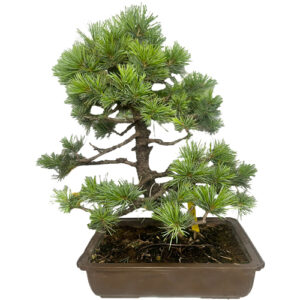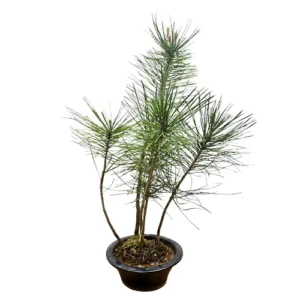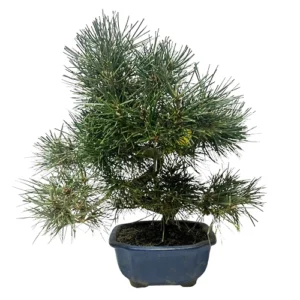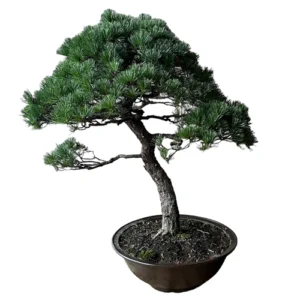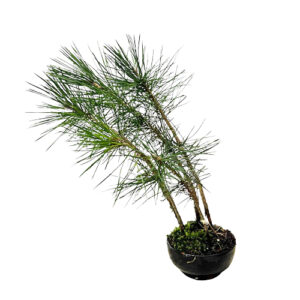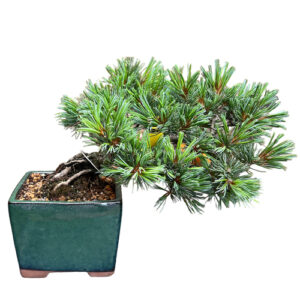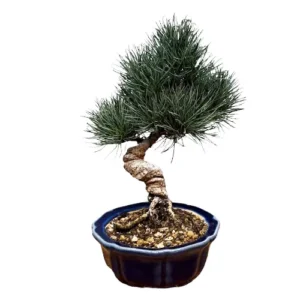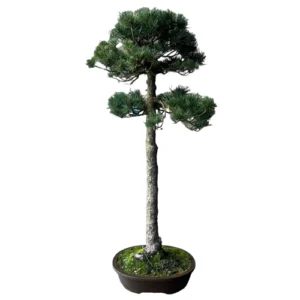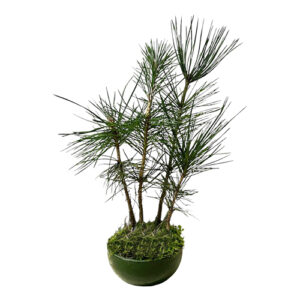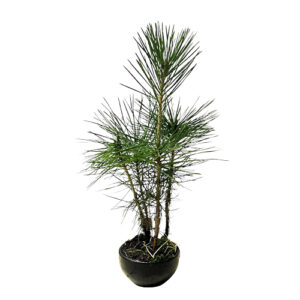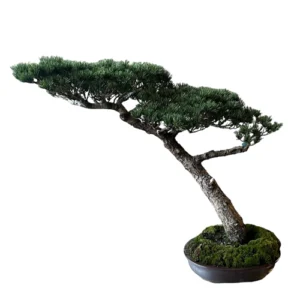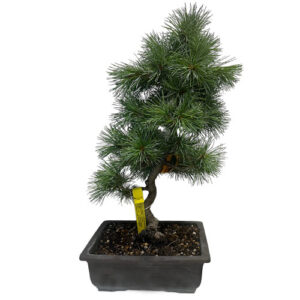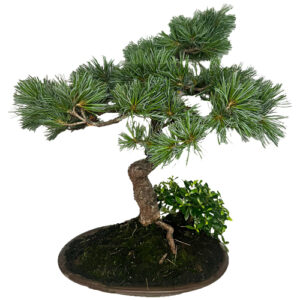Pinus Parviflora
Japanese White Pine Bonsai
The Japanese white pine is a highly sought-after bonsai tree variety that has been trained in Japan and China for centuries. It is elegant, evergreen and highly ornamental when shaped well. This is a slower growing but very rewarding bonsai variety.
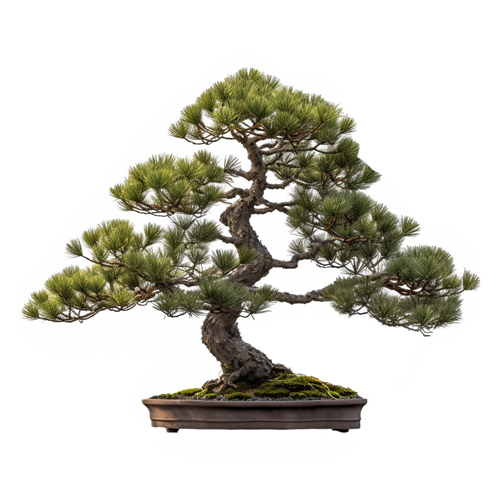
Japanese White Pine Bonsai Care Tips
Placement
The Japanese white pine is a very hardy species that can tolerate harsh conditions well and should be kept outdoors. Look for a spot that receives bright and full sun, the white pine will not thrive indoors. Pines are tolerant of shade but will grow longer needles to compensate for less light, a feature which is considered undesirable in bonsai art.
Action does not necessarily need to be taken during the winter as these species require a cooler period of about three months for dormancy. However, be aware that if the pot and soil freeze over, the pine will die of dehydration. We therefore recommend protecting your tree from frost and freezing temperatures. Consider using a cold frame or bringing it indoors to an unheated space such as a greenhouse to more safely allow for its dormancy period.
Watering
There is no definitive guide to watering and it should be conducted on an observational schedule, not a routine. This means that it is important to keep an eye on the moisture levels of the soil to avoid over and under watering, both which can lead to dropping leaves and/or root death. The amount of water a bonsai requires depends on pot size, climate, airflow, soil and tree type so it is best to use your eyes and fingers to assess whether the soil is damp, wet or dry.
If the top inch or so of soil has dried, it is ready to be watered. When you water, try to get an even coverage over the roots and soil, allowing water to flow out from the bottom of the pot to ensure a good soaking.
If you are a first-time bonsai owner, another way to water is by submerging the entire pot in water until the bubbles stop. If you choose this method, be aware that your bonsai may not need watering for another two to four days, but this will depend on the factors mentioned above such as soil type, pot size and climate.
Japanese white pines dislike permanent moisture so a well-draining soil is required and be careful not to overwater. Protect the trees from excess rain while shoots are developing because a lot of water will make the needles grow longer than necessary.
Feeding & Fertilising
Using fertiliser on your Japanese white pine will help encourage healthy growth and this should be done periodically from once a week to every two months and only during the growing season. You can start adding Chrysal Liquid Bonsai Feed to your water from March until October and use weekly. Use Naruko Fertiliser Slow Release Bonsai Feed once every one to two months. With Buddhist Pine trees, less is more, and we tend to advise using half the recommended dosage to see how your Buddhist Pine reacts first.
Pruning & Wiring
Pruning your bonsai is important not only to maintain or create an aesthetic style but to also ensure light and airflow can reach inner foliage. Japanese white pines grow quickly upwards, at the expense of lower branches and inner shoots. You can pinch back the growing tips during summer to thin out its growth and encourage lower branching and a more balanced structure. When new buds appear (candles), let them grow to around 3cm in length, and then cut them back down with sharp scissors to about halfway. If there are more than two candles on one branch or twig, remove the surplus but be sure to leave two. Do not remove all the candles at one time as this can result in death of the pine.
Training your Japanese white pine is possible as the branches are supple and can be bent easily, even into older age. Wire them from early autumn to early spring and leave the wires on for a long while, the white pine grows very slowly and is likely to bend back to its original shape if taken off too early. We recommend using wires with a thickness that matches the thickness of the branch: if the wire you choose is too thick you will damage the bark. If it is too thin, it won’t be effective.
Repotting
Repotting your tree is an important way to provide a fresh and suitable soil mix and ensure appropriate root health. Repot in early spring, just after the buds begin to swell and extend. Generally, your white pine will need to be re-potted once every two years if it is young, while older ones can stay in their pots for longer. However, you should always check if it has become root-bound before you change pots. You can do this by lifting the tree gently out of the pot by the main trunk and examining the root system. You will know it is ready if you can see that the roots are circling around each other and the pot. If, however, they still appear contained in the soil, you should place it back and wait until the following spring to check again.
Trees that are ready for repotting will require root pruning, a suitable new pot and appropriate soil mix.
When repotting, do not cut back the root mass by a large amount, and choose a well-draining soil mix that has a neutral or slightly higher PH value of 5-6 but not over 7. We tend to use a mixture of different speciality bonsai soils on our trees. Every species is different so please contact us for free soil-mix advice or to take advantage of our repotting service.
Bonsai trees aren’t only magnificent additions to an indoor oasis, they are more than capable of standing out in any garden. Many Bonsai species are incredibly hardy and withstand nature’s colder and damper turns with aplomb making them worthwhile outdoor plants. We have an extensive library of care guides for outdoor bonsai trees. It’s not about selecting the perfect bonsai, it’s about selecting the perfect bonsai for you.
Pinus is a colossal genus of conifer trees found throughout the northern hemisphere. Over 121 species exist and there are over 800 recognized cultivars. Among its several species cultivated for bonsai are the Mugo Pine and Japanese Black Pine. As well as their beautiful trees and Christmas trees, pine is one of the world’s most valued sources of lumber.
Japanese White Pine Bonsai - Typical Queries
How much sun does a Japanese White Pine Bonsai need?
A Japanese White Pine bonsai needs plenty of sunlight to thrive, but not direct exposure to harsh or scorching rays. Ideally, you should place your bonsai in a bright spot that receives morning or afternoon sun, but avoid midday sun or artificial light. You should also rotate your bonsai regularly to ensure even growth and prevent one-sided development.
Why is my Japanese White Pine Bonsai losing leaves?
There are several possible reasons why your Japanese White Pine bonsai might be losing leaves, such as overwatering, underwatering, root rot, fungal infection, insect infestation, or environmental stress. To prevent leaf loss, you should check the soil moisture, drainage, and aeration regularly, and water only when the top layer of soil feels slightly dry. You should also inspect your bonsai for any signs of disease or pests, and treat them accordingly. Additionally, you should avoid exposing your bonsai to extreme temperatures, drafts, or pollutants, and provide a stable and suitable environment for your bonsai.
Do Japanese White Pine Bonsai need a lot of water?
No, Japanese White Pine bonsai do not need a lot of water, as they are adapted to dry and rocky conditions. Overwatering can cause root rot, fungal growth, and leaf drop, which can be fatal for your bonsai. You should water your bonsai only when the soil feels slightly dry to the touch, and never let it dry out completely. You should also use a fine mist spray to moisten the foliage and needles, especially during hot and dry weather.

